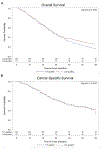Comparative Effectiveness of Computed Tomography- Versus Ultrasound-Guided Percutaneous Radiofrequency Ablation Among Medicare Patients 65 Years of Age or Older With Hepatocellular Carcinoma
- PMID: 30832966
- PMCID: PMC6402784
- DOI: 10.1016/j.jval.2018.10.004
Comparative Effectiveness of Computed Tomography- Versus Ultrasound-Guided Percutaneous Radiofrequency Ablation Among Medicare Patients 65 Years of Age or Older With Hepatocellular Carcinoma
Abstract
Background: For patients with hepatocellular carcinoma (HCC) not eligible for surgical resection, radiofrequency ablation (RFA) is a promising technique that reduces the risk of disease progression.
Objectives: To evaluate whether the trend of image guidance for RFA is moving toward the more expensive computed tomography (CT) technology and to determine the clinical benefits of CT guidance over the ultrasound (US) guidance.
Methods: A cohort of 463 patients was identified from the Surveillance, Epidemiology, and End Results and Medicare-linked database. The temporal trends in use of image guidance were assessed using the Cochrane-Armitage test. The associations between modality of image guidance and survival, complications, and costs were assessed using the Cox regression model, the logistic regression model, and the generalized linear model, respectively.
Results: The use of CT-guided RFA increased sharply, from 20.7% in 2002 to 75.9% in 2011. Compared with CT-guided RFA, those who received US-guided RFA had comparable risk of periprocedural and delayed postprocedural complications. Stratified analyses by tumor size also showed no statistically significant difference. In adjusted survival analysis, no statistically significant difference was observed in overall and cancer-specific survival. Nevertheless, the cost of CT-guided RFA ($2847) was higher than that of US-guided RFA ($1862).
Conclusions: Despite its rapid adoption over time, CT-guided RFA incurred higher procedural costs than US-guided RFA but did not significantly improve postprocedural complications and survival. Echoing the American Board of Internal Medicine's Choosing Wisely campaign and the American Society of Clinical Oncology's Value of Cancer Care initiative, findings from our study call for critical evaluation of whether CT-guided RFA provides high-value care for patients with HCC.
Keywords: HCC; RFA; costs; effectiveness; imaging.
Copyright © 2019 ISPOR–The Professional Society for Health Economics and Outcomes Research. Published by Elsevier Inc. All rights reserved.
Conflict of interest statement
DECLARATION OF INTERESTS
We declare no competing interests.
Figures



Similar articles
-
Iodized oil computed tomography versus ultrasound-guided radiofrequency ablation for early hepatocellular carcinoma.Hepatol Int. 2021 Oct;15(5):1247-1257. doi: 10.1007/s12072-021-10236-0. Epub 2021 Aug 2. Hepatol Int. 2021. PMID: 34338971
-
Image-guided microwave ablation of hepatocellular carcinoma (≤5.0 cm): is MR guidance more effective than CT guidance?BMC Cancer. 2021 Apr 7;21(1):366. doi: 10.1186/s12885-021-08099-7. BMC Cancer. 2021. PMID: 33827464 Free PMC article.
-
Effectiveness and cost of radiofrequency ablation and stereotactic body radiotherapy for treatment of early-stage hepatocellular carcinoma: An analysis of SEER-medicare.J Med Imaging Radiat Oncol. 2018 Oct;62(5):673-681. doi: 10.1111/1754-9485.12754. Epub 2018 Jun 7. J Med Imaging Radiat Oncol. 2018. PMID: 29877615
-
Review of dynamic contrast-enhanced ultrasound guidance in ablation therapy for hepatocellular carcinoma.World J Gastroenterol. 2011 Dec 7;17(45):4952-9. doi: 10.3748/wjg.v17.i45.4952. World J Gastroenterol. 2011. PMID: 22174544 Free PMC article. Review.
-
A Comparison of the Efficacy and Safety of US-, CT-, and MR-Guided Radiofrequency and Microwave Ablation for HCC: A Systematic Review and Network Meta-Analysis.Cancers (Basel). 2025 Jan 26;17(3):409. doi: 10.3390/cancers17030409. Cancers (Basel). 2025. PMID: 39941779 Free PMC article. Review.
Cited by
-
A prognostic model for thermal ablation of benign thyroid nodules based on interpretable machine learning.Front Endocrinol (Lausanne). 2024 Aug 19;15:1433192. doi: 10.3389/fendo.2024.1433192. eCollection 2024. Front Endocrinol (Lausanne). 2024. PMID: 39224123 Free PMC article.
-
Overall Survival and Complication Rates in the Treatment of Liver Carcinoma: A Comparative Study of Ultrasound, Computed Tomography, and Combined Ultrasound and Computed Tomography Guidance for Radiofrequency Ablation.Diagnostics (Basel). 2025 Jul 11;15(14):1754. doi: 10.3390/diagnostics15141754. Diagnostics (Basel). 2025. PMID: 40722504 Free PMC article.
-
Comparative Study of Application of Computed Tomography/Ultrasound and Computed Tomography Imaging Guidance Methods in the Microwave Ablation of Liver Cancer.J Comput Assist Tomogr. 2023 Jan-Feb 01;47(1):24-30. doi: 10.1097/RCT.0000000000001375. Epub 2022 Sep 1. J Comput Assist Tomogr. 2023. PMID: 36055224 Free PMC article.
-
Comparison of Computed Tomography and Ultrasound-Guided Radiofrequency Ablation for Recurrent Subdiaphragmatic Hepatocellular Carcinoma After Resection.J Hepatocell Carcinoma. 2025 Jun 27;12:1231-1240. doi: 10.2147/JHC.S524399. eCollection 2025. J Hepatocell Carcinoma. 2025. PMID: 40599642 Free PMC article.
-
Medical imaging and nuclear medicine: a Lancet Oncology Commission.Lancet Oncol. 2021 Apr;22(4):e136-e172. doi: 10.1016/S1470-2045(20)30751-8. Epub 2021 Mar 4. Lancet Oncol. 2021. PMID: 33676609 Free PMC article. Review.
References
-
- American Cancer Society. Cancer Facts & Figures 2018. Atlanta: American Cancer Society, 2018.
-
- Cancer Stat Facts: Liver and Intrahepatic Bile Duct Cancer. National Cancer Institute; 2018.
Publication types
MeSH terms
Grants and funding
LinkOut - more resources
Full Text Sources
Medical
Miscellaneous

